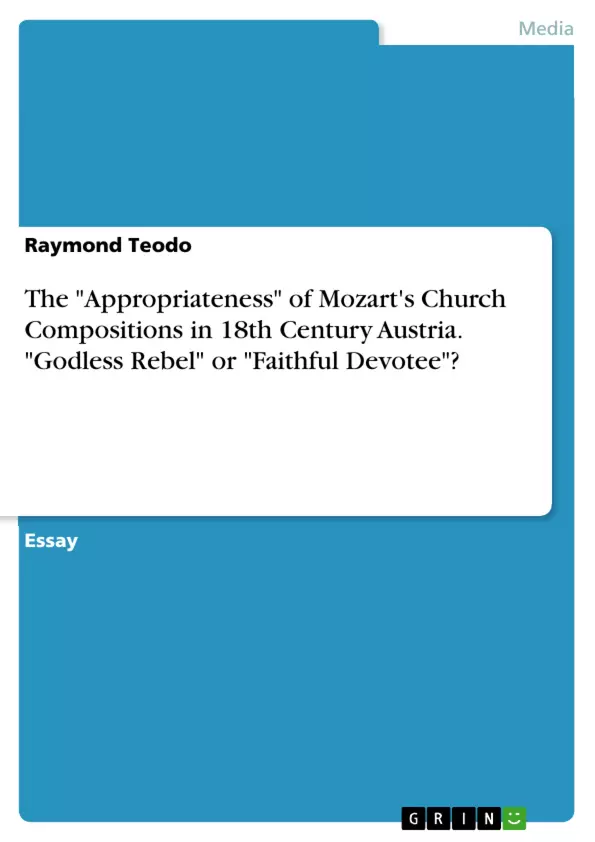This essay deals with Mozart’s Requiem (K626) and describes what aspects of the Requiem would have been deemed 'problematic' under the conventions that the church placed upon their music compositions, and explains how these 'problematic' elements actually complemented what effect church music was supposed to evoke for 18th Century Austrian parishioners.
Mozart's Requiem has been the subject of debate in terms of its innovativeness and 'appropriateness' for 18th Century Church music, within the historical context in which it was composed. Some have argued that its failure to strictly adhere to the conventions that the Church placed upon Church music composition of the day, meant that Mozart was deliberately 'rebelling' against Church policy.
However, a closer study of the historical context, in conjunction with particular events in the composer's life surrounding the development of this composition, indicate that Mozart was actually trying to support the Church's stance on providing music that is both moving, reverent and sacred, albeit taking some liberties that perhaps a lesser well-known and respected composer might not have been able to get away with.
Inhaltsverzeichnis (Table of Contents)
- It is important when discussing the “appropriateness” of Mozart’s church compositions to understand the historical context in which they were written.
- Mozart’s Spatzenmesse (K220) is the first composition which demonstrates his attempt to comply with the new changes (Küster 39).
- The Mass in C Minor (K.427) (1782-83) was written not long after Mozart had left Colloredo’s service (Zaslaw 14).
- The most obvious operatic elements in the piece are found in the Gloria and Credo sections, namely in “Laudamus te” and “Et incarnatus est” (Landon, “The Mozart Essays”, 184, Mozart 20 - 27, 87-95, Zaslaw 15).
- The fact that Mozart chose to write the text in Latin is another important factor to note.
- Assuming that Colloredo really did prefer having church compositions to be written in the key of C (Geiringer 370), the fact that the Mass is written in C Minor can also be seen as another “inappropriate” element.
- It could be interpreted from these examples that Mozart was somewhat of a “rebel,” who defied the changes that had been implemented. However, scholars have argued that this is not the case at all.
- Most important to note is Konrad Küster’s account of the opposition Mozart faced from jealous critics (many of whom unfortunately remain anonymous in his book).
Zielsetzung und Themenschwerpunkte (Objectives and Key Themes)
This essay examines the debate surrounding the “appropriateness” of Mozart’s church compositions in 18th century Austria, exploring the tension between traditional church music and the emerging operatic styles. It aims to demonstrate that Mozart’s works, while innovative, were not intended to be a rebellion against liturgical changes, but rather a nuanced reflection of the evolving musical landscape.
- The historical context of liturgical changes in Austria during Mozart’s time.
- The influence of operatic styles on church music and the debate surrounding their appropriateness.
- Mozart’s approach to balancing traditional church music with contemporary operatic elements.
- The role of Archbishop Colloredo’s influence on liturgical practices and the limitations imposed on composers.
- The examination of Mozart’s Mass in C Minor as a case study for exploring the delicate balance between innovativeness and conformity.
Zusammenfassung der Kapitel (Chapter Summaries)
The essay begins by establishing the historical context of church music in Austria, highlighting the acceptance of operatic styles prior to the arrival of Archbishop Colloredo. It then examines the changes Colloredo implemented, emphasizing his preference for reverence and restraint in liturgical music. This shift led to restrictions on operatic elements and a focus on textual clarity. Mozart’s Mass in C Minor (K. 427) is then presented as a focal point, analyzing its operatic elements, particularly in the Gloria and Credo sections. The essay explores how these elements, while innovative, might have been perceived as “inappropriate” due to their potential distraction from the sacredness of the mass. It further discusses the use of Latin text and the choice of C minor as possible points of contention. The essay concludes by refuting the notion that Mozart was a “rebel” against liturgical changes, emphasizing that his works were deeply rooted in the tradition of church music and intended to glorify the Lord.
Schlüsselwörter (Keywords)
The essay focuses on the themes of liturgical music, church composition, operatic styles, historical context, Mozart’s Mass in C Minor, Archbishop Colloredo, and the balance between innovation and tradition in sacred music.
- Arbeit zitieren
- Raymond Teodo (Autor:in), 2010, The "Appropriateness" of Mozart's Church Compositions in 18th Century Austria. "Godless Rebel" or "Faithful Devotee"?, München, GRIN Verlag, https://www.hausarbeiten.de/document/966852


